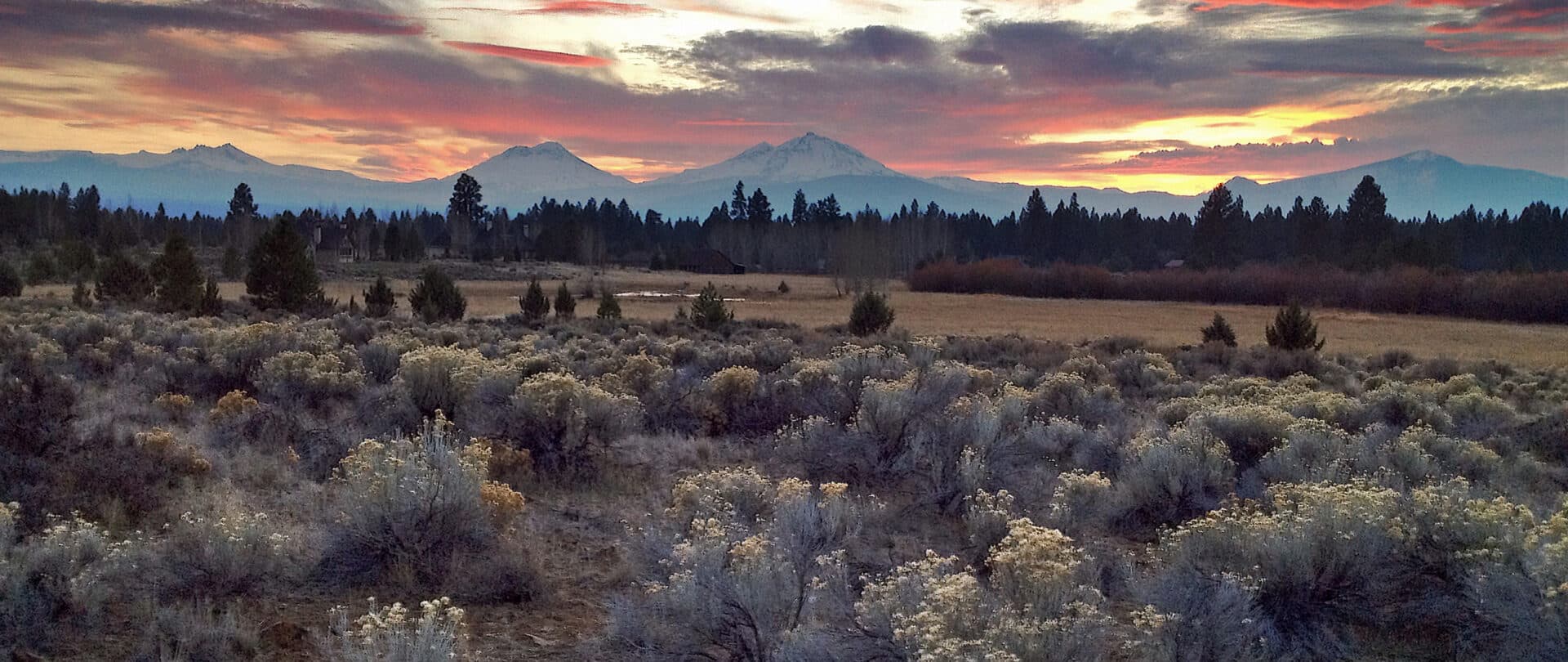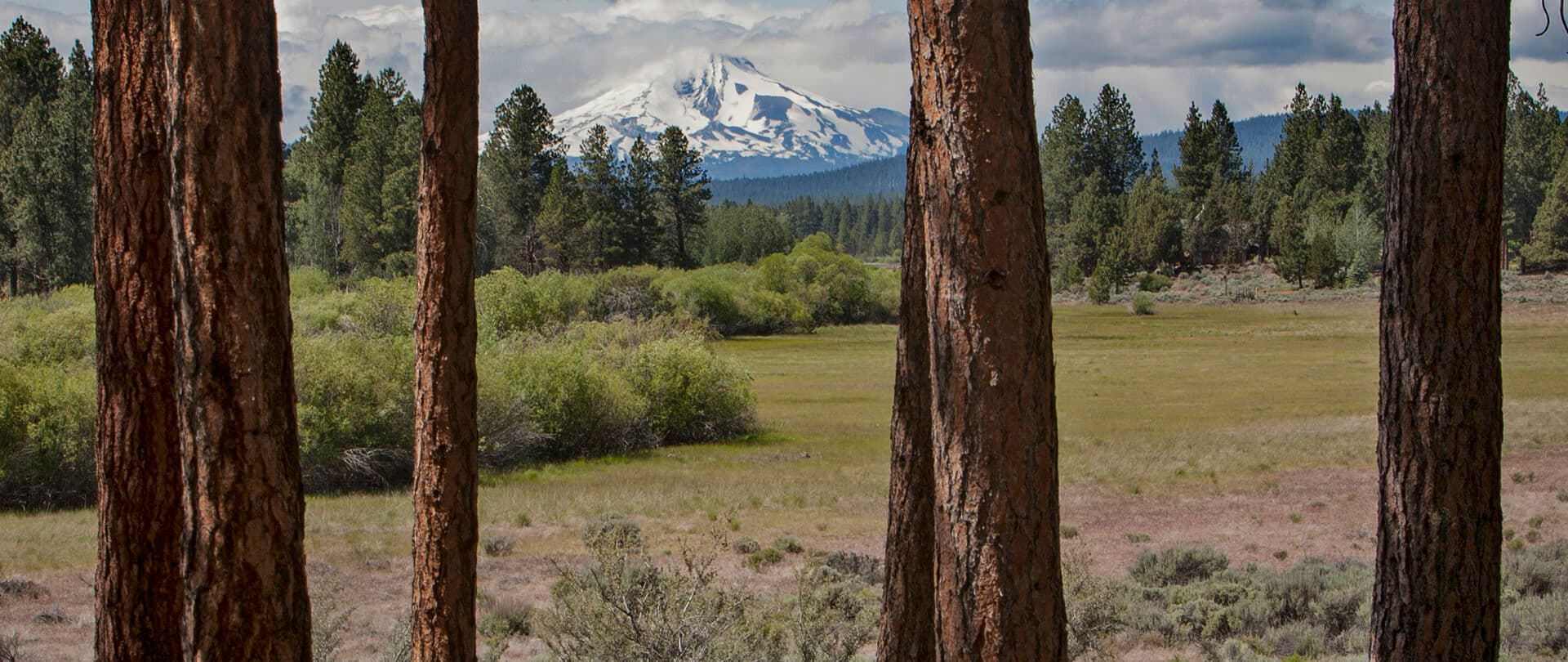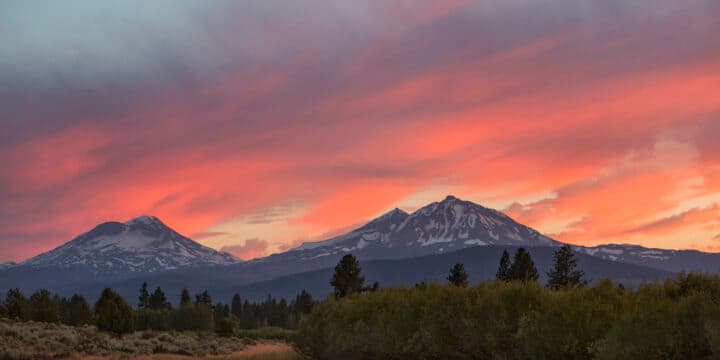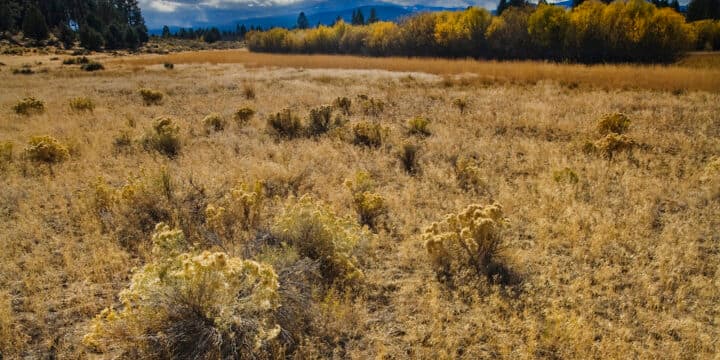Preserving Nature
Since 1995, Deschutes Land Trust has worked with private landowners to permanently protect scenic land and waterways, starting with the Indian Ford Meadow Preserve.
BY Meghan Robbins Images by Jay Mather
Step between sage and rabbit brush, past ancient junipers, and ponderosa pines. Meander through velvety meadows bursting with wildflowers, bunchgrass, and aspen groves, and glimpse the willow-lined Indian Ford Creek at Indian Ford Meadow Preserve.
Located three miles north of Sisters, Oregon, and 30 miles northwest of Bend, the entrance to Indian Ford Meadow Preserve is unassuming: park on an unpaved shoulder, unchain a lone red gate, and find the informative trailhead sign a dozen yards off the road.
Whether you start left or right down the one-mile Founder’s Trail loop, your reward is extraordinary views of seven peaks, including the Three Sisters, Broken Top, Mt. Washington, Black Butte, and Mt. Jefferson. Rest on various trailside benches, perfect for observing nearly 100 species of birds, along with mule deer, elk, beaver, coyote, fish, and other wildlife. There is a quiet intimacy to this special place and a long history.
Once these expansive riparian meadows stretched uninterrupted from Black Butte, an extinct stratovolcano that looms to the northwest, all the way to Indian Ford Creek’s confluence with Whychus Creek, three miles south. Eventually these waters join the Deschutes River, flow north into the Columbia River, and finally reach the Pacific Ocean.
Indian Ford Meadow Preserve is a unique landscape with both wet and dry meadows. Wet meadows are a repository for water flowing out of the mountains, allowing the rush of snowmelt to spread and soak into the surrounding landscape. This spread and storage of water distributes nutrients and creates a natural filter that cleans and keeps the water cool. During warmer months, when the streams and rivers are low, the cold water from wet meadows releases back into the rivers, providing critical relief for fish, amphibians, plants, and wildlife.
Dry meadows found on the east side of Indian Ford Meadow Preserve are areas where wildflowers and tall grasses thrive, providing pollen and habitat for butterflies and insects, which attract rodents and small birds, which attracts raptors and larger predators. Deer and elk are often found in dry meadows grazing on grasses and plant life. Historically, fires kept trees from encroaching on meadow lands, which preserved the open spaces needed for more fragile, sun-driven plants to grow.
From time immemorial, the area now called “Central Oregon” has been the traditional lands of the Wasco (Wasq’u) and Warm Springs (Tana’nma) peoples, with crossover from many neighboring nations. The Wasco nation, principally fishermen who lived along the Columbia River, traded foods like root bread, salmon meal and bear grass with neighboring nations for goods like beads, roots, game, clothes, and horses. Members of the Warm Springs Nation living along Columbia River’s tributaries moved seasonally between summer and winter residences, following game, fish spawning, and specific roots and berry harvests.
Neighboring nations, including the Wasco-Wishram (Chinookan), Klamath, Molalla, Tenino, Tygh, Wyam, John Day (Sahaptin), and Paiute (Numu) peoples sometimes traveled into the area for trade and harvesting seasons as well. Members of the Northern Paiute Nation traveled from the Great Basin when following game patterns north. Archeologists have found evidence that Indigenous peoples have been living in Central Oregon since at least 13,000 years ago.
The Indigenous peoples frequenting these meadows use extensive knowledge from generations of observation, understanding, and active management to maintain the important innerworkings of both wet and dry meadow landscapes. Many Indigenous nations use fire to encourage new growth, clear landscapes for better hunting, and are active participants in helping plants and animals flourish. Today, members of the Confederated Tribes of Warm Springs maintain their rights to fish, hunt, and harvest at traditional locations. Landowner Deschutes Land Trust considers the Confederated Tribes of Warm Springs a critical partner in the continual management and restoration of Indian Ford Meadow Preserve.
In the early 1800s, when Euro-Americans invaded native lands, they called it “Oregon Territory” and brought with them horses and cattle who quickly overgrazed meadows, muddied streams, and eventually built fences that altered the landscapes for everyone. European fur trappers routing through the Cascades in search of beaver were the first recorded non-natives to enter the area. They were following the Deschutes River, which some called “Indian Road.”
In 1825, Peter Skene Ogden of the Hudson Bay Company became the first Euro-American to record grazing horses at Indian Ford Meadow specifically. Thirty years later in 1855, two United States Army lieutenants, Lt. Robert Williamson and Lt. Henry Abbot, led their Pacific Railroad Survey team into the meadow while searching for possible railroad routes. At the time, Congress instructed Secretary of War Jefferson Davis to determine how best to connect the Sacramento Valley to the Transcontinental Railroad. Davis charged Williamson and Abbot to explore the Willamette and Deschutes Rivers specifically.
Routes mapped by U.S. survey teams were quickly used as guides for unsanctioned westward migration throughout Indigenous territories. The inappropriate advertising by the United States government of free land for any (white) person who wanted it inspired half a million squatters to invade Wasco and Warm Springs territory via the Oregon Trail between the 1830s and 1860s.
With thousands of Euro-American squatters arriving, and more on the way, Oregon Territory superintendent Joel Palmer negotiated with members of the Wasco and Warm Springs nations to cede ten million acres to the United States government. Under the Treaty of 1855, these nations ceded their ancestral lands along the profuse salmon fishing waters of the Columbia River, trading it for 640,000 acres of land pinched between two smaller tributaries with poorer soil on the Warm Spring Reservation.
Twenty-four years later in 1879, when 38 members of the Paiute Nation who fought alongside the Bannocks against the U.S. Army were forced off the Yakama Reservation, they moved to the Warm Springs Reservation. The Paiute people eventually became a permanent addition. Today, these three nations, with their extremely diverse languages, customs, histories, and traditions, are collectively known as the Confederated Tribes of Warm Springs.
By the 1860s, Euro-American immigrants were building homesteads in Central Oregon and a large section near Indian Ford Creek became part of the Willows Ranch, opening the meadows and fragile vegetation to grazing livestock. In 1865, the completion of the Santiam Wagon Road established direct access to the Willamette Valley, bringing more colonization and capitalism to Central Oregon.

Fast forward to 1995, through 120 years of sheep and cattle ranching, building fences, and private home development, when two critical moments coincided: the owners of the historic Willows Ranch were interested in donating their fallow, but scenic, pasture, and a group of public employees in Bend were contemplating a regional land trust to protect the serenity, views, and wildlife of Central Oregon. Their conversation led to the founding of the Deschutes Basin Land Trust in 1995. Their flagship project was creating the Indian Ford Meadow Preserve, which was completed in May 1996.
Today, the Deschutes Land Trust owns this scenic 63-acre preserve, which is open to the public during daylight hours. Every year, volunteers dedicate time to restoration projects like pulling non-native weeds including Phalaris arundinacea, or reed canary grass, which earns volunteers the title of “Phalaris Fairies.” Other projects include fencing aspens from grazing elk and mule deer, removing young juniper trees from dry meadow areas, and thinning ponderosa pine stands while creating snags for nesting birds.
Deschutes Land Trust’s mission is “To conserve and care for the lands and waters that sustain Central Oregon, so local communities and the natural world can flourish together for generations to come.” They are nationally accredited and a 501(c3) nonprofit working with local landowners to protect land voluntarily and permanently, which can be made public or not; and they offer conservation and tax benefits to landowners. With 12 staff members, 10 board members, advisors, and stewards, the Deschutes Land Trust works hard to provide balance and solutions for Central Oregon’s ever-growing population.
In 2017, the one-mile Founder’s Trail, which was named in honor of the Deschutes Land Trust’s original 11 members, was extended to offer visitors more stable footing and to better experience Indian Ford Creek’s meadows and sweeping mountain views. Nearly 100 species of songbirds and birds of prey, wild turkeys, coyotes, mule deer, elk, beavers, amphibians, fish, aspen groves, willows, and hundreds of other high desert species call this special place home.
As an ecologically diverse place with dry meadows, wet meadows, and unparalleled views of seven volcanic mountains, Indian Ford Meadow Preserve is every student of environmental science’s dream: Teachers and students from elementary school to university and beyond regularly engage with the preserve through bird walks, artist meetups, science studies, yoga in the trees, and self-guided walks. No matter who you are, or how long you’ve been in Central Oregon, the Indian Ford Meadow Preserve is a place for intimate connections to nature, a few moments of solace, and a lovely meandering along a welcoming trail.
Before you go, plan your trip accordingly. Check for timely details, like seasonal closure and mud conditions, on DeschutesLandTrust.org. Then bike or drive the 2.7 miles from downtown Sisters and park at the gate. The one-mile loop, made of dirt and gravel with a few rocky sections, is great for kids and hikers of all ages. Dogs on leash are allowed, but bikes, horses, and motor vehicles are not. There are no toilets or garbage cans; and, as with every hike in Central Oregon whether it’s short or long, be sure to bring water. Regardless of what time of year you visit, please stay on the trail, which is the only and best way to enjoy and preserve this fragile and beautiful landscape.




